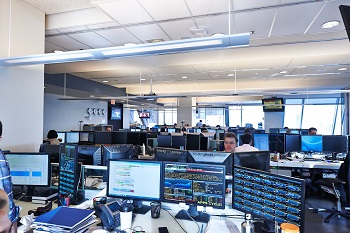“It’s impossible to understand institutional investing today without also understanding the role of technology,” says Jay Vyas, Head of Quantitative Investing in the Public Market Investments department at CPPIB. Large institutional investors like CPPIB are invested in thousands of public companies around the world and, importantly, trade in volumes where individual sell or buy orders are potentially large enough to impact market price. This means that how equities are bought or sold can be as important as what those equities are. The race to generate the insights that inform decisions on where to make investments and then to execute those decisions in the optimal way is won by those who can quickly build sophisticated technology solutions that can harness enormous amounts of data and turn it into meaningful, actionable information.
Faster than a speeding bit

“Investors compete with each other to increase their share of a finite amount of alpha,” explains Jay. Those able to make the best decisions about what to invest in, do so more quickly than others, and then execute those decisions flawlessly, can get a bigger piece of the pie. “If you can generate data-driven insights the fastest, and can act on those insights, you can gain a competitive edge.”
In CPPIB’s Quantitative Investing team, a group of experts aggregates huge volumes of data from disparate sources on thousands of securities going back for decades – about such things as companies’ fundamentals, volume of trading, price, corporate actions, and so on. The group then organizes that data in ways that allow for analysts to generate actionable insights. The key is to be able to access the data, aggregate it, and then organize and present it in a way that allows analysts to quickly generate the insights that those with access to the same data may not be able to do.
“We operate somewhat like a tech company,” says Jay. “We use state-of-the-art software technologies to develop technical solutions to custom-develop highly specialized tools that make all of this happen.” It’s the sophistication behind these tools, the ability to develop them quickly, and then the skill required to harness their power that provides the edge.”
Harnessing big data
This same drive for speed is part of what motivates the team led by Manjeet Ram, Senior Portfolio Manager in CPPIB’s Global Capital Markets group. The Electronic Trading team works to leverage technology to analyze and react to market data – data that often changes within microseconds – to optimize decision-making related to the execution of trades.
There are a host of factors that are considered when determining how (and when) to optimize execution – including market capacity, sourcing liquidity, information leakage and of course size and price. Unlike with personal trading, the volume of buy and sell orders executed by CPPIB can actually drive prices up or down. That’s why trade execution strategies are key to optimizing the overall profitability of each public market investment.

As part of this strategy, Manjeet’s team tracks and records changes in the price of thousands of securities traded on exchanges around the world. Team members analyze the data in the context of past executions and apply the insights to design new trading algorithms, which are then used to determine the best methodology for executing trades. “In essence, we focus on teaching a machine to analyze data and optimally execute trades” explains Manjeet. “By using insights informed by huge amounts of data we’re able to ensure that our trades are executed in most efficient and profitable way possible.”
The art and science of trading algorithms
Manjeet’s team works in three disciplines: One focuses on the technology itself; one does research in support of refining the algorithms; and one executes the trading solutions. But in a unique approach, each team member is versed across all of those disciplines. By having this broad perspective where everyone is skilled in technology, research and execution, the team is able to build more innovative solutions, and do so more quickly. Members whose expertise is in, say, execution, know what’s needed to drive the technology solutions and ensure that the appropriate research is carried out. “It’s an iterative process of continuous improvement where everyone contributes to all aspects of the solution,” says Manjeet. And with members coming from extremely diverse professional backgrounds – one is a former stem cell researcher, one has a degree in chemistry, another has a PhD. in math – they’re able to apply broad perspectives to help drive truly innovative and differentiating solutions.
Manjeet, who once considered a career in animation and then pursued cryptography, sees a parallel between technology, science and art: “There’s as much creativity in coding as there is in drawing,” he says. “We’re combining multiple disciplines to come up with innovative ways of developing and applying algorithms. It’s truly a creative discipline that requires a blend of technical knowledge, mathematical expertise, pure ingenuity and imagination.”










